Showing Spotlights 161 - 168 of 201 in category All (newest first):
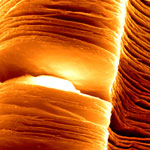 Clean and affordable energy generation and storage is one of the most significant challenges that our world is facing in the 21st century. Materials are going to play a crucial role in generation and storage of renewable energy. While searching for new materials for electrical energy storage, materials scientists have discovered a new family of two-dimensional compounds proposed to have unique properties that may lead to ground-breaking advances in energy storage technology. Researchers transformed three dimensional titanium-aluminum carbide into a two dimensional structure with greatly different properties. This work opens the door for a wide range of metal carbide and/or nitride compositions in form of 2-D sheets.
Clean and affordable energy generation and storage is one of the most significant challenges that our world is facing in the 21st century. Materials are going to play a crucial role in generation and storage of renewable energy. While searching for new materials for electrical energy storage, materials scientists have discovered a new family of two-dimensional compounds proposed to have unique properties that may lead to ground-breaking advances in energy storage technology. Researchers transformed three dimensional titanium-aluminum carbide into a two dimensional structure with greatly different properties. This work opens the door for a wide range of metal carbide and/or nitride compositions in form of 2-D sheets.
Aug 29th, 2011
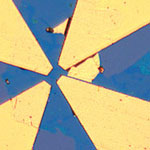 Surface energy is ubiquitous in nature and it plays an important role in many scientific areas such as for instance surface physics, biophysics, surface chemistry, or catalysis. Prior to the area of nanotechnology it has been impractical to consider utilizing surface energy as an energy source because there are few molecules or atoms involved in the surface interaction and the density of surface energy is low. Now, however, due to the lower power consumption requirements of nanoscale devices and the higher specific surface area for nanomaterials it appears attractive to use surface energy at the nanoscale. In new work, researchers have investigated how the flow of water over surfaces coated with graphene could generate small amounts of electricity.
Surface energy is ubiquitous in nature and it plays an important role in many scientific areas such as for instance surface physics, biophysics, surface chemistry, or catalysis. Prior to the area of nanotechnology it has been impractical to consider utilizing surface energy as an energy source because there are few molecules or atoms involved in the surface interaction and the density of surface energy is low. Now, however, due to the lower power consumption requirements of nanoscale devices and the higher specific surface area for nanomaterials it appears attractive to use surface energy at the nanoscale. In new work, researchers have investigated how the flow of water over surfaces coated with graphene could generate small amounts of electricity.
Jul 25th, 2011
 Energy generation and storage is an important issue at the nanoscale. For tiny devices such as nano- and micro-electromechanical systems, autonomous power sources are crucial for practical applications. Progress is being made in designing and fabricating nanoscale power generators. But, as with the large, macroscale systems of future smart grids, there might be times when powered nanodevices need to bridge a slump in power generation/harvesting or they might be designed to run on stored energy altogether for a limited period of time. Researchers in China are now proposing that the high energy density and power density of carbon nanotubes makes them promising materials for the storage of mechanical energy. The team provides a structural model towards mechanical energy storage for nanodevices and also demonstrates a method to characterize and manipulate ultralong CNTs.
Energy generation and storage is an important issue at the nanoscale. For tiny devices such as nano- and micro-electromechanical systems, autonomous power sources are crucial for practical applications. Progress is being made in designing and fabricating nanoscale power generators. But, as with the large, macroscale systems of future smart grids, there might be times when powered nanodevices need to bridge a slump in power generation/harvesting or they might be designed to run on stored energy altogether for a limited period of time. Researchers in China are now proposing that the high energy density and power density of carbon nanotubes makes them promising materials for the storage of mechanical energy. The team provides a structural model towards mechanical energy storage for nanodevices and also demonstrates a method to characterize and manipulate ultralong CNTs.
Jul 11th, 2011
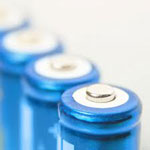 The efforts undertaken in developing renewable energy sources to reduce our dependence on fossil fuels include major research and investment in advanced electricity storage technologies. Among the various existing technologies, lithium batteries are considered as the most competitive power source because of their high energy density, superior power capability, design flexibility and longer lifespan. This article provides an overview of the current patent landscape of rechargeable Li-ion battery, with a focus on the recent developments on nanomaterials and nanotechnologies used for anode, cathode, and electrolyte materials, and the impact of nanomaterials on the performance of rechargeable lithium batteries. Effort has also been taken to identify key players, emerging trends and applications in this area.
The efforts undertaken in developing renewable energy sources to reduce our dependence on fossil fuels include major research and investment in advanced electricity storage technologies. Among the various existing technologies, lithium batteries are considered as the most competitive power source because of their high energy density, superior power capability, design flexibility and longer lifespan. This article provides an overview of the current patent landscape of rechargeable Li-ion battery, with a focus on the recent developments on nanomaterials and nanotechnologies used for anode, cathode, and electrolyte materials, and the impact of nanomaterials on the performance of rechargeable lithium batteries. Effort has also been taken to identify key players, emerging trends and applications in this area.
Jul 1st, 2011
 Notwithstanding all the buzz about renewable energy sources, the dirty facts are that coal accounts for 41% of electricity production worldwide. Since, realistically, coal will be a mainstay of electricity generation for many years to come, research into more environmentally friendly use of coal energy is picking up steam. One technology for more efficient power production centers around the solid oxide fuel cell (SOFC). Especially gasified carbon fuel cells offer great prospects for the most efficient utilization of a wide variety of carbonaceous solids fuels, including coal, biomass, and municipal solid waste. Researchers have now developed a self-cleaning technique that could allow solid oxide fuel cells to be powered directly by coal gas at operating temperatures as low as 750 degrees Celsius.
Notwithstanding all the buzz about renewable energy sources, the dirty facts are that coal accounts for 41% of electricity production worldwide. Since, realistically, coal will be a mainstay of electricity generation for many years to come, research into more environmentally friendly use of coal energy is picking up steam. One technology for more efficient power production centers around the solid oxide fuel cell (SOFC). Especially gasified carbon fuel cells offer great prospects for the most efficient utilization of a wide variety of carbonaceous solids fuels, including coal, biomass, and municipal solid waste. Researchers have now developed a self-cleaning technique that could allow solid oxide fuel cells to be powered directly by coal gas at operating temperatures as low as 750 degrees Celsius.
Jun 28th, 2011
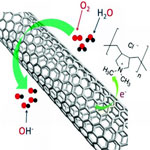 The efficiency of catalyzing the oxygen reduction reaction (ORR) - the process that breaks the bonds of oxygen molecules - to a large degree determines the electrochemical performance of fuel cells. Platinum and platinum-based composites have long been considered as the most efficient ORR catalysts. In their search for practically viable non-precious metal ORR catalysts, researchers have also been investigating vertically-aligned nitrogen-containing carbon nanotubes. Having a strong electron-withdrawing ability, poly(diallyldimethylammonium chloride) (PDDA) was used to create net positive charge for carbon atoms in the nanotube carbon plane via intermolecular charge transfer. The resultant PDDA functionalized/adsorbed carbon nanotubes were demonstrated to act as metal-free catalysts for oxygen reduction reaction in fuel cells with similar performance as platinum catalysts.
The efficiency of catalyzing the oxygen reduction reaction (ORR) - the process that breaks the bonds of oxygen molecules - to a large degree determines the electrochemical performance of fuel cells. Platinum and platinum-based composites have long been considered as the most efficient ORR catalysts. In their search for practically viable non-precious metal ORR catalysts, researchers have also been investigating vertically-aligned nitrogen-containing carbon nanotubes. Having a strong electron-withdrawing ability, poly(diallyldimethylammonium chloride) (PDDA) was used to create net positive charge for carbon atoms in the nanotube carbon plane via intermolecular charge transfer. The resultant PDDA functionalized/adsorbed carbon nanotubes were demonstrated to act as metal-free catalysts for oxygen reduction reaction in fuel cells with similar performance as platinum catalysts.
Mar 21st, 2011
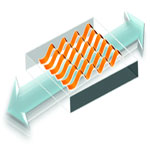 Previous research has shown that high performance piezoelectric ceramics PZT (lead zirconate titanate) could be printed as nanoribbons onto biocompatible and flexible substrates for applications such as harvesting energy from human motion like walking or breathing. While some motions, such as walking, only require flexibility, others, such as breathing, require that the materials be not just flexible but also stretchable. However, the PZT ribbons cannot stand stretching operation modes due to their brittle nature, which leads to cracking. The research team therefore has been looking to overcome this difficulty by fashioning the piezoelectric ribbons into wavy shapes, and integrating them with stretchable silicone rubber, such that the composite material can withstand large amounts of elastic strain.
Previous research has shown that high performance piezoelectric ceramics PZT (lead zirconate titanate) could be printed as nanoribbons onto biocompatible and flexible substrates for applications such as harvesting energy from human motion like walking or breathing. While some motions, such as walking, only require flexibility, others, such as breathing, require that the materials be not just flexible but also stretchable. However, the PZT ribbons cannot stand stretching operation modes due to their brittle nature, which leads to cracking. The research team therefore has been looking to overcome this difficulty by fashioning the piezoelectric ribbons into wavy shapes, and integrating them with stretchable silicone rubber, such that the composite material can withstand large amounts of elastic strain.
Feb 18th, 2011
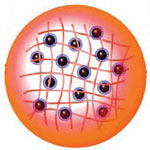 The particular physical properties that result from their unusual state of matter - they combine the properties of solids and fluids - make hydrogels ideal candidates for a number of applications. Nanoscale colloidally stable particles made from hydrogels are referred to as nanogels and these material systems have many general advantages, such as high transparency, high diffusion rates, high surface area, high dispersion stability, and monodispersity. Researchers in Japan have now proposed a novel photochemical application toward artificial photosynthesis using nanogels as nanogenerators, which evolve hydrogen gas from the internal water induced by irradiation with visible light. Actually, these nanogel systems generated hydrogen gas more efficiently than conventional solution systems.
The particular physical properties that result from their unusual state of matter - they combine the properties of solids and fluids - make hydrogels ideal candidates for a number of applications. Nanoscale colloidally stable particles made from hydrogels are referred to as nanogels and these material systems have many general advantages, such as high transparency, high diffusion rates, high surface area, high dispersion stability, and monodispersity. Researchers in Japan have now proposed a novel photochemical application toward artificial photosynthesis using nanogels as nanogenerators, which evolve hydrogen gas from the internal water induced by irradiation with visible light. Actually, these nanogel systems generated hydrogen gas more efficiently than conventional solution systems.
Feb 17th, 2011
 Clean and affordable energy generation and storage is one of the most significant challenges that our world is facing in the 21st century. Materials are going to play a crucial role in generation and storage of renewable energy. While searching for new materials for electrical energy storage, materials scientists have discovered a new family of two-dimensional compounds proposed to have unique properties that may lead to ground-breaking advances in energy storage technology. Researchers transformed three dimensional titanium-aluminum carbide into a two dimensional structure with greatly different properties. This work opens the door for a wide range of metal carbide and/or nitride compositions in form of 2-D sheets.
Clean and affordable energy generation and storage is one of the most significant challenges that our world is facing in the 21st century. Materials are going to play a crucial role in generation and storage of renewable energy. While searching for new materials for electrical energy storage, materials scientists have discovered a new family of two-dimensional compounds proposed to have unique properties that may lead to ground-breaking advances in energy storage technology. Researchers transformed three dimensional titanium-aluminum carbide into a two dimensional structure with greatly different properties. This work opens the door for a wide range of metal carbide and/or nitride compositions in form of 2-D sheets.
 Subscribe to our Nanotechnology Spotlight feed
Subscribe to our Nanotechnology Spotlight feed





